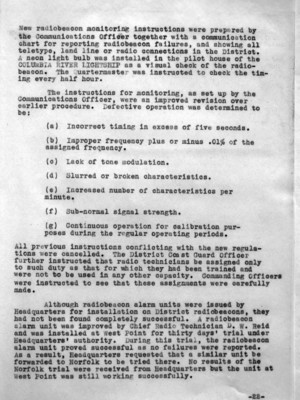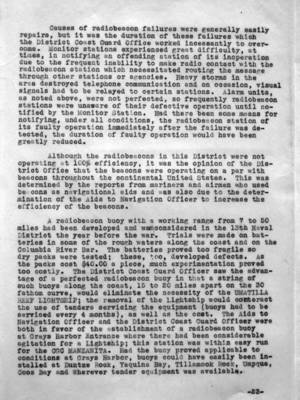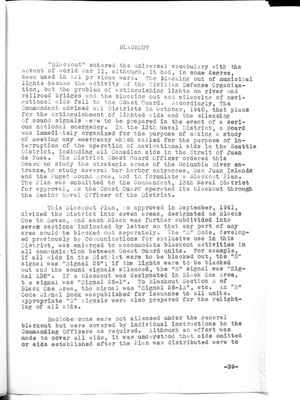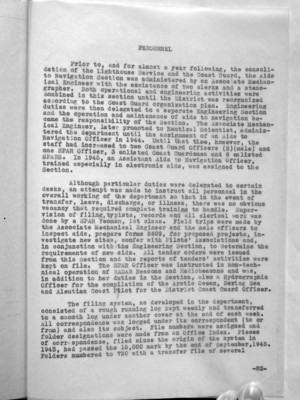Pages That Mention radiobeacons
Coast Guard District narrative histories 1945
41
New radiobeacon monitoring instructions were prepared by the Communications Officer together with a communication chart for reporting radiobeacon failures, and showing all teletype, land line or radio connections in the District. A neon light bulb was installed in the pilot house of the COLUMBIA RIVER LIGHTSHIP as a visual check of the radiobeacon. The Quartermaster was instructed to check the timing every half hour.
The instructions for monitoring, as set up by the Communications Officer, were an improved revision over earlier procedure. Defective operation was determined to be:
(a) Incorrect timing in excess of five seconds.
(b) Improper frequency plus or minus .01% of the assigned frequency.
(c) Lack of tone modulation.
(d) Slurred or broken characteristics.
(e) Increased number of characteristics per minute.
(f) Sub-normal signal strength.
(g) Continuous operation for calibration purposes during the regular operating periods.
All previous instructions conflicting with the new regulations were cancelled. The District Coast Guard Officer further instructed that radio technicians be assigned only to such duty as that for which they had been trained and were not to be used in any other capacity. Commanding Officers were instructed to see that these assignments were carefully made.
Although radiobeacon alarm units were issued by Headquarters for installation on District radiobeacons, they had not been found completely successful. A radiobeacon alarm unit was improved by Chief Radio Technician D. W. Reid and was installed at West Point for thirty days' trial under Headquarters' authority. During this trial, the radiobeacon alarm unit proved successful as no failures were reported. As a result, Headquarters requested that a similar unit be forwarded to Norfolk to be tried there. No results of the Norfolk trial were received from Headquarters but the unit at West Point was still working successfully.
-22-
42
Causes of radiobeacon failures were generally easily repairs, but it was the duration of these failures which the District Coast Guard Office worked incessantly to overcome. Monitor stations experienced great difficulty, at times, in notifying an offending station of its inoperation due to the frequent inability to make radio contact with the radiobeacon station which necessitated routing the message through other stations or agencies. Heavy storms in the area destroyed telephone communication and on occasion, visual signals had to be relayed to certain stations. Alarm units, as noted above, were not perfected, so frequently radiobeacon stations were unaware of their defective operation until notified by the Monitor Station. Had there been some means for notifying, under all conditions, the radiobeacon station of its faulty operation immediately after the failure was detected, the duration of faulty operation would have been greatly reduced.
Although the radiobeacons in this District were not operating at 100% efficiency, it was the opinion of the District Office that the beacons were operating on a par with beacons throughout the continental United States. This was determined by the reports from mariners and airmen who used beacons as navigational aids and was also due to the determination of the Aids to Navigation Officer to increase the efficiency of the beacons.
A radiobeacon buoy with a working range from 7 to 50 miles had been developed and was considered in the 13th Naval District the year before the war. Trials were made on batteries in some of the rough waters along the coast and on the Columbia River Bar. The batteries proved too fragile so dry packs were tested; these, too, developed defects. As the packs cost $40.00 a piece, much experimentation proved too costly. The District Coast Guard Officer saw the advantage of a perfected radiobeacon buoy in that a string of such buoys along the coast, 15 to 20 miles apart on the 30 fathom curve, would eliminate the necessity of the UMATILLA REEF LIGHTSHIP; the removal of the Lightship would counteract the use of tenders servicing the equipment (buoys had to be serviced every 4 months), as well as the cost. The Aids to Navigation Officer and the District Coast Guard Officer were both in favor of the establishment of a radiobeacon buoy at Grays Harbor Entrance where there had been considerable agitation for a Lightship; this station was within easy run for the CGC MANZANITA. Had the buoy proved applicable to conditions at Grays Harbor, buoys could have easily been installed at Duntze Rock, Yaquina Bay, Tillamook Rock, Umpqua, Coos Bay and Wherever tender equipment was available.
-23-
59
"Blackout" entered the universal vocabulary with the advent of World War II, although, it had, in some degree, been used in all previous wars. The blacking out of municipal lights became the activity of the Civilian Defense Organization, but the problem of extinguishing lights on river and railroad bridges and the blacking out and silencing of navigational aids fell to the Coast Guard. Accordingly, The Commandant advised all Districts in October, 1940, that plans for the extinguishment of lighted aids and the silencing of sound signals were to be prepared in the event of a serious national emergency. In the 13th Naval District, a Board was immediately organized for the purpose of making a study of meeting any emergency which called for the purpose of interruption of the operation of navigational aids in the Seattle District, including all Canadian aids in the Strait of Juan de Fuca. The District Coast Guard Officer ordered this Board to study the Strategic areas of the Columbia River entrance, to study several bar harbor entrances, San Juan Islands and the Puget Sound Area, and to formulate a Blackout Plan. The Plan was submitted to the Commandant, 13th Naval District for approval, as the Coast Guard operated its blackout through the Senior Naval Officer of the District.
This Blackout Plan, as approved in September, 1941, divided the District into seven areas, designated as Blacks One to Seven, and each Black was further subdivided into seven sections indicated by letter so that any part of any area could be blacked out separately. The "S" Code, developed previously by Communications for exclusive use in this District, was enlarged to accommodate blackout activities in all communication between Coast Guard units. For example, if all aids in the District were to be blacked out, the "S" signal was "Signal 26"; if the lights were to be blacked out and the sound signals silenced, the "S" signal was "Signal 138". If a blackout was designated in Black One Area, the signal was "Signal 26-1A", etc. An "S" Code Signal Book was published for issuance to all units. Appropriate "S" signals were also prepared for the relighting of all aids.
Radiobeacons were not silenced under the general blackout but were covered by individual instructions to the Commanding Officers as required. Although an effort was made to cover all aids, it was understood that aids omitted or aids established after the Plan was distributed were to
-39-
69
daily and then having no assurance that relighting was accomplished. In order to verify the conditions that existed in connection with this situation, visibility tests were made on all ten buoys twice each day without the use of control equipment. A tabulation sheet showing all ten controlled buoys, the date and hour, an indication of each buoy light that was visible before 0800 and after 1200 each day was submitted to the District Coast Guard Office weekly. In 3920 observations, lights were visible by telescope from Cape Disappointment Lookout Station only 2900 times. This figure included all ten buoys listed on the previous page, during period from 17 July, 1944, to 12 February, 1945, at which time the visibility tests were discontinued.
By November, 1944, Headquarters became interested in the peace time value of ANRAC and requested that the District Coast Guard Officer prepare a list of such locations in the 13th Naval District where ANRAC could be used for peace time operation. The major complicated features (essential for security) were to be simplified to meet peace time application to unattended radiobeacons or fog signals where maintenance by an operating crew and expenses related thereto presented objectionable difficulties. In response, the District Coast Guard Office listed five fog signals near the mouth of the Columbia River within a three mile radius from Point Adams Lifeboat Station, Hammond, Oregon, and the fog signals at Tacoma Waterway, Milwaukie Shoal and Point Defiance all within a radius of 4 1/2 miles of Browns Point Light near Tacoma, Washington. However, the District Coast Guard Officer did not feel that ANRAC control of shore lights during peace time would have any advantage over the sun relays currently installed due to the higher cost and a greater possibility for human error.
Headquarters was requested, since the war time ANRAC program had proved unsatisfactory, that authority to discontinue the radio control of the lights on the buoys at the entrance to the Columbia River be granted. Due to the fact
(image)
PARTRIDGE POINT FOG SIGNAL ANRAC CONTROLLED FROM SMITH ISLAND LIGHT STATION, 6.5 MILES DISTANT. EQUIPMENT OPERATED MOST SUCCESSFULLY SINCE INSTALLATION
-49-
103
Prior to, and for almost a year following, the consolidation of the Lighthouse Service and the Coast Guard, the Aids to Navigation Section was administered by an Associate Mechanical Engineer with the assistance of two clerks and a stenographer. Both operational and engineering activities were combined in this section until the District was reorganized according to the Coast Guard organizational plan. Engineering duties were then delegated to a separate Engineering Section and the operation and maintenance of aids to navigation became the responsibility of the Section. The Associate Mechanical Engineer, later promoted to Nautical Scientist, administered the department until the assignment of an Aids to Navigation Officer in 1944. Until that time, however, the staff had increased to two Coast Guard Officers (R) (male) and one SPAR Officer, 3 enlisted Coast Guardsmen and 6 enlisted SPARS. in 1945, An Assistant Aids to Navigation Officer, trained especially in electronic Aids, was assigned to the Section.
Although particular duties were delegated to certain desks, an attempt was made to instruct all personnel in the overall working of the department so that in the event of transfer, leave, discharge, or illness, there was no obvious vacancy that required complete training to handle. Supervision of filing, typists, records and all clerical work was done by a SPAR Yeoman, 1st class. Field trips were made by the Associate Mechanical Engineer and the male officers to inspect aids, prepare forms 2609, for proposed projects, investigate new sites, confer with Pilots' Associations and, in conjunction with the Engineering Section, to determine the requirements of new aids. All tender orders were issued from this Section and the reports of tenders' activities were kept on file. The SPAR Officer was instructed in non-technical operation of RADAR Beacons and Radiobeacons and was, in addition to her duties in the Section, also a Hydrographic Officer for the compilation of the Arctic Ocean, Bering Sea and Aleutian Coast Pilot for the District Coast Guard Officer.
The filing system, as developed in the department, consisted of a rough running log kept weekly and transferred to a smooth log under another cover at the end of each week. All correspondence was logged under its correspondent (to or from) and also its subject. File numbers were assigned and folder designations were made from an Office Index. Pieces of correspondence, filed since the origin of the system in 1943, had passed the 15,000 mark by the end of September, 1945. Folders numbered to 730 with a transfer file of several -83




